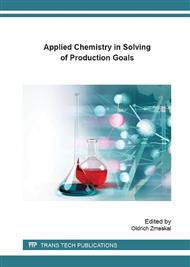p.110
p.116
p.125
p.130
p.135
p.141
p.147
p.153
p.159
Fluorescence Analysis of Cu(II), Pb(II) and Hg(II) Ion Binding to Humic and Fulvic Acids
Abstract:
Abstract. The aim of this work was to study molecular and quantitative aspects of metal ion binding to humic substances (HS). The object of our study was characterization of two standards of humic substances (Elliott Soil standard HA 1S102H and Elliott Soil standard FA 2S102F). All samples of IHSS standards HS were characterized by elemental analysis (EA), ultraviolet-visible spectroscopy (UV/Vis), Fourier transform infrared spectroscopy (FTIR) and steady-state fluorescence spectroscopy. Chemical parameters on the complexation of Cu (II), Pb(II) and Hg(II), including the conditional stability constants and the percentage of fluorophores participating in the complexation, were estimated by the modified Stern–Volmer equation. The stability constants (log Ka) of Me(II)–ESHS complexes range from 3.70 to 5.15 in the order: Hg–ESHA>Cu–ESHA>Pb–ESHA>Cu–ESFA>Pb–ESFA. With respect to the ESHA, ESFA, which showed the smallest contents of O-containing functional groups (e.g. hydroxyl, carbonyl, ester, especially carboxyl groups on the aromatic ring) and the lowest humification degree, the ESFA was characterized by much smaller stability constants. Our findings suggest that soil HS belongs to class of important organic ligands for complexation with heavy metal ions and may significantly affect the chemical forms, mobility, bioavailability and ecotoxicity of heavy metals in the soil environment.
Info:
Periodical:
Pages:
135-140
Citation:
Online since:
April 2016
Price:
Сopyright:
© 2016 Trans Tech Publications Ltd. All Rights Reserved
Share:
Citation:


